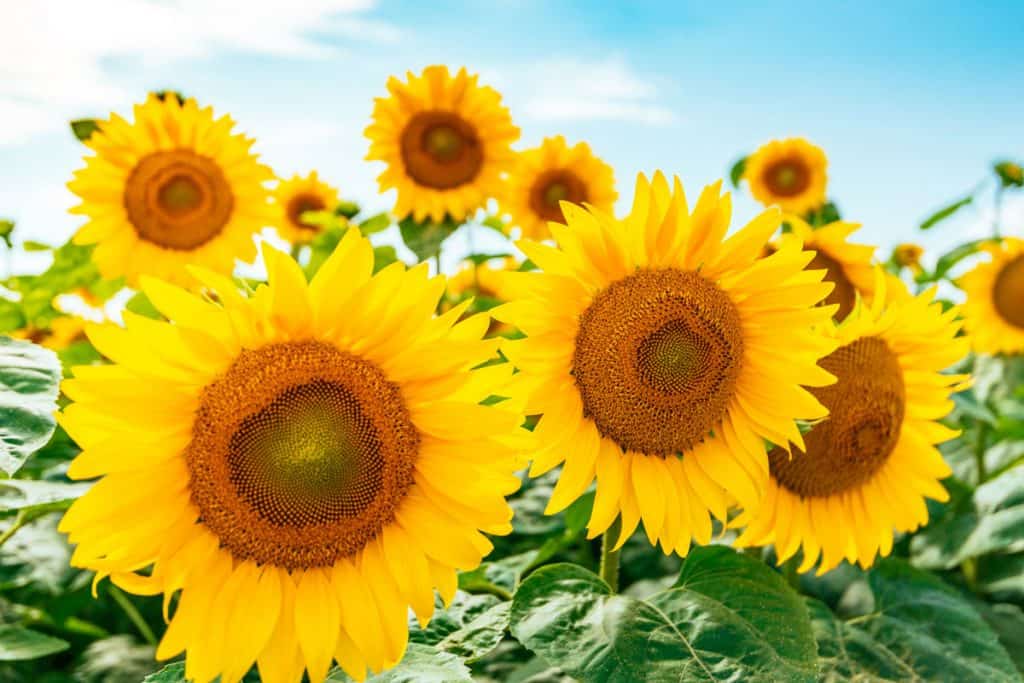 Sunflowers are a lovely sight to behold. The flowers are celebrated via festivals, useful for ornamental decoration, provide tasty, nutritious seeds, and are perfect additions in gardens. But, do these gorgeous golden-hued blooms grow back? Whether you are curious about harvest season, winter, or varieties of sunflowers, we have done the research for you to help you better understand sunflowers. Keep reading to learn some fascinating tidbits about this festive flower.
Sunflowers are a lovely sight to behold. The flowers are celebrated via festivals, useful for ornamental decoration, provide tasty, nutritious seeds, and are perfect additions in gardens. But, do these gorgeous golden-hued blooms grow back? Whether you are curious about harvest season, winter, or varieties of sunflowers, we have done the research for you to help you better understand sunflowers. Keep reading to learn some fascinating tidbits about this festive flower.
Yes, it is possible for sunflowers to grow back. If a sunflower variety is a perennial, it will naturally return and blossom again the following year. Annual varieties must be replanted every year. Sunflowers will also grow back if they are self-germinating, growing from seeds that may fall off of the plant, provided the heads are left on in the winter.
Depending on what zone you live in, how you care for your sunflowers, and the variety of sunflowers you grow will influence whether your blooms grow back. Some gardeners may have questions about whether they should cut off the heads of their sunflowers or what happens to sunflower seeds that are left behind in the garden. If you want to know more about sunflowers and their life cycle, please continue to read on.
What Makes Sunflowers Bloom?

There are two types of sunflowers that you will encounter, being either the Helianthus annuus, which is annual or the Helianthus multiflorus, which is perennial. If you want your sunflowers to bloom, you will need to have ample space for the roots to spread out and establish themselves, a location with access to full sunlight, and well-draining soil that is rich in nutrients. It is advisable to keep to a regular watering schedule depend on the climate zone you live in, and the weather, plus adding fertilizer to encourage tall, healthy sunflowers, is a plus.
You can encourage your sunflowers to create more blossoms by deadheading them as necessary, maintaining an environment that allows them to thrive, and choosing perennial varieties that return each year. Make sure to properly prepare your garden and sunflowers for winter to help them come back more robust each year. Save seeds that can be germinated the following year from annual sunflowers.
Growing sunflowers is a rewarding experience for gardeners of all experience levels. You can successfully grow sunflowers outdoors or indoors. Make sure to choose your variety of sunflowers wisely for the best results. It is understandable to adjust your approach with raising this hardy and resilient flower in your garden, depending on your location and the flower variety's needs.
Do Sunflowers Rebloom?

Once a sunflower fully matures, it displays its colorful blossom to the world and eventually bears edible seeds. However, do sunflowers rebloom? This depends on if you are growing an annual variety or a perennial variety.
Perennial sunflowers are the type that will grow back every year, provided they have enough sunlight, space, proper nutrition, and adequate watering. Annual sunflowers typically bloom once and need to be planted again next year. However, you might get new sunflowers emerging from annual sunflower types from seed that has fallen to the soil after it perishes. Additionally, it is critical to properly winterize your garden and protect sunflowers, so they are more likely to rebloom next year.
If you need help identifying whether your sunflower is most likely a perennial or annual type, here's an easy hint. Perennial sunflowers have smaller seed heads and often grow in a bush form with plenty of blooms.
Check out this mix of sunflower seeds for planting on Amazon.
Check out this prairie variety of sunflowers on Amazon.
Should Sunflowers Be Deadheaded?
There are a few reasons you would want to deadhead a sunflower. First off, if you are growing a variety of sunflower with multiple blooms on a stalk, it is better to remove some of the blooms to allow the strongest to thrive. The key to deadheading sunflowers is to remove blooms that are wilting, damaged, or fading away before they produce seeds.
When a sunflower undergoes deadheading, it is a signal to the plant to produce more blooms. So, yes, consider deadheading your perennial sunflowers to enjoy more beautiful, long-lasting flowers. Also, if you want to harvest any seeds from blooms that you deadhead, wait until the back of the bloom turns yellow. You can collect the seeds after you place the flower in a well-ventilated place to dry and fully mature.
Check out this tall variety of stately sunflower on Amazon.
Check out this handy pair of pruning shears on Amazon.
What to Do With a Sunflower After it Dies?
That old sunflower that has bloomed and towered in the garden is compost worthy after death. Unless your sunflower has been ravaged with pests and disease and you need to clear your garden, feel free to use dead sunflowers to nurture your future garden plants and soil as nutrients. When harvesting seeds from sunflowers, you will want to cut the stem a foot down from the dead bloom, once the head has turned yellow or brown. The petals should be dead, but the seeds left behind should be full. Keep the head in a dry but ventilated area and knock the seeds off.
When harvesting sunflowers for the compost pile, you will want to cut the stalk at the level of the soil. Feel free to add dead flower heads and leaves that have been shredded to the compost pile for additional nutrients. Also, thoroughly shredding up sunflower parts helps reduce their toxicity. Remember, do not use sunflowers that have succumbed to disease or pests in your compost pile, lest you contaminate your organic fertilizer.
Check out this gorgeous variety of sunflower on Amazon.
Check out this set of gardening gloves on Amazon.
Check out these great articles to learn more about the sunflower.
23 Sunflower Garden Idea You'll Love






